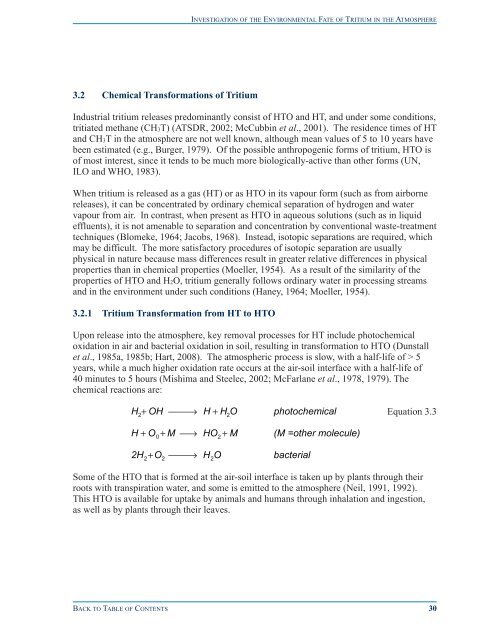Investigation of the Environmental Fate of Tritium in the Atmosphere
Investigation of the Environmental Fate of Tritium in the Atmosphere
Investigation of the Environmental Fate of Tritium in the Atmosphere
Create successful ePaper yourself
Turn your PDF publications into a flip-book with our unique Google optimized e-Paper software.
3.2 Chemical Transformations <strong>of</strong> <strong>Tritium</strong><br />
INVESTIGATION OF THE ENVIRONMENTAL FATE OF TRITIUM IN THE ATMOSPHERE<br />
Industrial tritium releases predom<strong>in</strong>antly consist <strong>of</strong> HTO and HT, and under some conditions,<br />
tritiated methane (CH3T) (ATSDR, 2002; McCubb<strong>in</strong> et al., 2001). The residence times <strong>of</strong> HT<br />
and CH3T <strong>in</strong> <strong>the</strong> atmosphere are not well known, although mean values <strong>of</strong> 5 to 10 years have<br />
been estimated (e.g., Burger, 1979). Of <strong>the</strong> possible anthropogenic forms <strong>of</strong> tritium, HTO is<br />
<strong>of</strong> most <strong>in</strong>terest, s<strong>in</strong>ce it tends to be much more biologically-active than o<strong>the</strong>r forms (UN,<br />
ILO and WHO, 1983).<br />
When tritium is released as a gas (HT) or as HTO <strong>in</strong> its vapour form (such as from airborne<br />
releases), it can be concentrated by ord<strong>in</strong>ary chemical separation <strong>of</strong> hydrogen and water<br />
vapour from air. In contrast, when present as HTO <strong>in</strong> aqueous solutions (such as <strong>in</strong> liquid<br />
effluents), it is not amenable to separation and concentration by conventional waste-treatment<br />
techniques (Blomeke, 1964; Jacobs, 1968). Instead, isotopic separations are required, which<br />
may be difficult. The more satisfactory procedures <strong>of</strong> isotopic separation are usually<br />
physical <strong>in</strong> nature because mass differences result <strong>in</strong> greater relative differences <strong>in</strong> physical<br />
properties than <strong>in</strong> chemical properties (Moeller, 1954). As a result <strong>of</strong> <strong>the</strong> similarity <strong>of</strong> <strong>the</strong><br />
properties <strong>of</strong> HTO and H2O, tritium generally follows ord<strong>in</strong>ary water <strong>in</strong> process<strong>in</strong>g streams<br />
and <strong>in</strong> <strong>the</strong> environment under such conditions (Haney, 1964; Moeller, 1954).<br />
3.2.1 <strong>Tritium</strong> Transformation from HT to HTO<br />
Upon release <strong>in</strong>to <strong>the</strong> atmosphere, key removal processes for HT <strong>in</strong>clude photochemical<br />
oxidation <strong>in</strong> air and bacterial oxidation <strong>in</strong> soil, result<strong>in</strong>g <strong>in</strong> transformation to HTO (Dunstall<br />
et al., 1985a, 1985b; Hart, 2008). The atmospheric process is slow, with a half-life <strong>of</strong> > 5<br />
years, while a much higher oxidation rate occurs at <strong>the</strong> air-soil <strong>in</strong>terface with a half-life <strong>of</strong><br />
40 m<strong>in</strong>utes to 5 hours (Mishima and Steelec, 2002; McFarlane et al., 1978, 1979). The<br />
chemical reactions are:<br />
H 2+ OH H + H O<br />
2 photochemical Equation 3.3<br />
H + O 0 + M HO 2 + M (M =o<strong>the</strong>r molecule)<br />
2H 2 +O 2 H 2O bacterial<br />
Some <strong>of</strong> <strong>the</strong> HTO that is formed at <strong>the</strong> air-soil <strong>in</strong>terface is taken up by plants through <strong>the</strong>ir<br />
roots with transpiration water, and some is emitted to <strong>the</strong> atmosphere (Neil, 1991, 1992).<br />
This HTO is available for uptake by animals and humans through <strong>in</strong>halation and <strong>in</strong>gestion,<br />
as well as by plants through <strong>the</strong>ir leaves.<br />
BACK TO TABLE OF CONTENTS 30



